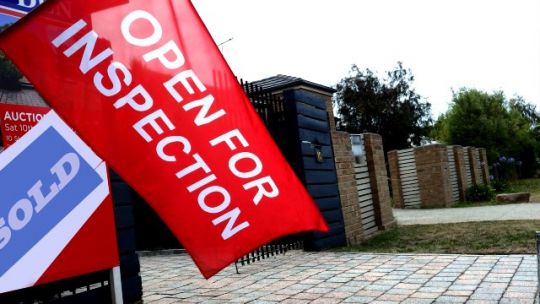RBA holds, as homeowners navigate 'catch-22' property market

Data released this week revealed property prices are rising sooner than expected. Sellers might be tempted to capitalise on these conditions, but would then join the hoards of buyers vying for limited stock, creating a pricing surge that could put pressure on the Reserve Bank to increase rates.
The Reserve Bank of Australia (RBA) predicts a low cash rate will be here to stay for at least three years, reflected in this week’s decision to keep the official interest rate at the record low of 0.10% in March.
But the RBA may develop second thoughts about this timing for a rate rise, as some initial signs of economic recovery have begun to emerge – namely, rising house prices.
Canstar finance expert Steve Mickenbecker said the central bank could find itself under pressure to bring forward cash rate rises if it can, due to property price pressure occurring a lot sooner than it may have expected.
CoreLogic reported on Monday that Australian home prices had surged 2.1% higher in February, the largest monthly increase recorded by the property research house since August 2003.
The heated property market may be driving more than just anxious buyers trying to get into the market to avoid missing out on government incentives and record-low lending rates. It could also be contributing to a ‘tug of war’ between restricted supply and increased demand that’s creating a timing mismatch.
What will be the circuit breaker?
“We are in a bit of a catch-22,” Mr Mickenbecker said of the current supply-demand conundrum.
He noted that property listings are currently few and far between in many parts of the country, with homes often being purchased before or as soon as they hit the market. This in turn is leaving some sellers reluctant to put a house up for sale, even at high prices, out of fear it could be difficult to find a new place to live.
Indeed, CoreLogic’s latest data suggests housing supply is much lower now than it was last year, as it shows the number of properties advertised for sale in February around the country remained 26.2% below 2020 levels.
Meanwhile, demand for property is high, creating a perfect storm for high house prices.
“Property demand has run way ahead, with the fear of missing out becoming a powerful psychological driver as government incentives and low interest rates have encouraged first home buyers and home builders into the market in a rush,” Mr Mickenbecker said.
“Market forces must eventually slow the pace of demand, but we are going to have to see an increase in property listings to get us to that point.”
He said some of this increase in supply would likely come from investors looking to sell, since they can walk away from a sale with a capital gain and no pressing housing need, unlike owner-occupiers.
“Buyers will be feeling a lot of pressure before this all plays out, and the Reserve Bank will be looking for a circuit breaker,” he said.
Low interest rates to entice buyers
Buyers may continue to be encouraged by low interest rates, with Canstar’s database showing there has been plenty of downwards movement on home loan rates in February despite the cash rate remaining on hold.
In fact, 15 lenders cut 53 variable home loan rates by an average of 0.25 percentage points in February. Fixed rates have also crept lower, after 15 lenders reduced 235 fixed loan rates by an average of 0.13 percentage points. Only three lenders increased fixed home loan rates last month.
Home loan providers that cut interest rates in February included ANZ, Bankwest, Bank of Queensland, CUA, HSBC, ING and National Australia Bank, among others.
Last month also saw Greater Bank introduce the new lowest-ever home loan rate for owner-occupiers on Canstar’s database, with several one-year fixed rate products coming in at 1.69% (comparison rates from 3.49%).
For a full list of the top home loan rates available at the time of writing, according to our database, see below.
Top 5 lowest owner-occupier home loan rates on Canstar’s database
| Lender | Loan | Rate | Comparison Rate^ | Max LVR |
| Greater Bank | Great Rate Fixed 1 yr | 1.69% | 3.49% | 95% |
| UBank | UHomeLoan Fixed P&I 3 yrs | 1.75% | 2.22% | 80% |
| Homestar Finance | Star Gold Home Loan <60% | 1.79% | 1.84% | 60% |
| HSBC | Home Loan Package Owner Occupier Fixed P&I 2 yrs | 1.88% | 2.86% | 80% |
| Pacific Mortgage Group | Variable P&I <60% | 1.89% | 1.89% | 60% |
Source: www.canstar.com.au – 1/03/2021. Based on owner-occupier, principal and interest loans available for a loan of $400,000 on Canstar’s database. ^Comparison rate calculated on a loan of $150,000 over 25 years. Read the comparison rate warning. Top 5 selected and table sorted in ascending order by rate, followed by comparison rate, with one product shown per provider. LVR (loan-to-value ratio) refers to the home loan amount as a percentage of the property’s value.
This article was reviewed by our Sub Editor Tom Letts before it was updated, as part of our fact-checking process.

The comparison rate for all home loans and loans secured against real property are based on secured credit of $150,000 and a term of 25 years.
^WARNING: This comparison rate is true only for the examples given and may not include all fees and charges. Different terms, fees or other loan amounts might result in a different comparison rate.
 Owner occupied
Owner occupied
 20% min deposit
20% min deposit
 Redraw facility
Redraw facility
Try our Home Loans comparison tool to instantly compare Canstar expert rated options.





